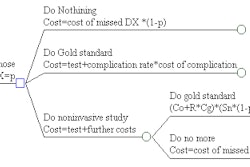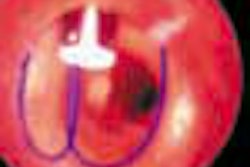BALTIMORE - Interventional procedures can expose equipment operators, as well as patients, to high radiation doses. But simple changes in positioning and pulse rates can reduce operator dose by 75% or more without reducing effectiveness or image clarity, according to a presentation Monday at the Society of Cardiovascular and Interventional Radiology (SCVIR) meeting.
Using a Keithley radiation survey meter and a whole-body phantom, Dr. David Freiman of the University of Pennsylvania Health System in Philadelphia measured radiation dose at various locations with respect to the patient and the central beam. With the operator standing in a typical position to perform an abdominal procedure, he made further measurements while varying pulse, field size, electronic and geometric magnification, and the presence or absence of a ceiling-mounted lead shield. All measurements were made on a six-month-old Multistar-TOP interventional suite from Siemens Medical Solutions of Iselin, NJ, he said.
"If you have a busy interventional practice -- on the floor about 30 minutes a day or 10 hours in a month -- (and) if you wear your badges religiously, you’ll find they come up a little higher than your hospital is probably comfortable with," Freiman said.
For example, standing 0.7 meters away from the patient rather than 0.4 meters away reduces dose 71%; reducing the field size to 8 x 8 inches reduces dose by 50%; and reducing the fluoroscopic mode to 15 pulses per second drops it another 50%. Combining those three modifications reduces scatter dose to the operator by a factor of 12.
Lowering a ceiling shield to about 10 inches above a patient did not reduce the dose at tabletop level, but did reduce radiation exposure to thyroid, eye, head, and neck by 80%, Freiman reported. Compared to continuous fluoroscopy, reducing the pulse to 30 pulses per second did not reduce radiation exposure. Dropping it to 15 pulses per second reduced dose by 50%, and further lowering it to 7.5 pulses per second reduced dose by 75% with impaired image quality. Collimation of a 40-cm image intensifier reduced dose by 27% with a 30 x 30-cm field, and by 58% with a 20 x 20-cm field.
Electronic magnification increased operator dose by 20% in 20-cm mode and by 69% in 14-cm mode, but "electronic magnification is where you get the most bang for your radiation buck," said Freiman.
"We know all these things very well, but people probably aren’t aware of how much they reduce dose," commented Dr. Ziv Haskal of New York-Presbyterian Hospital-Columbia University in New York City. "It’s such a necessary tool that we can lose sight of preventive measures as we focus on more complex interventions."
Because minimally invasive technologies often take longer to perform, they can increase the radiation dose to both operator and patient, which people are just beginning to take into account, he said.
By Damaris ChristensenAuntMinnie.com contributing writer
April 9, 2002
Related Reading
New protective devices shield interventional radiologists, February 5, 2002
CT dose study is good news for interventional radiologists, October 5, 2001
Low-dose CT fluoroscopy minimizes interventional exposure, July 30, 2001
Copyright © 2002 AuntMinnie.com


















